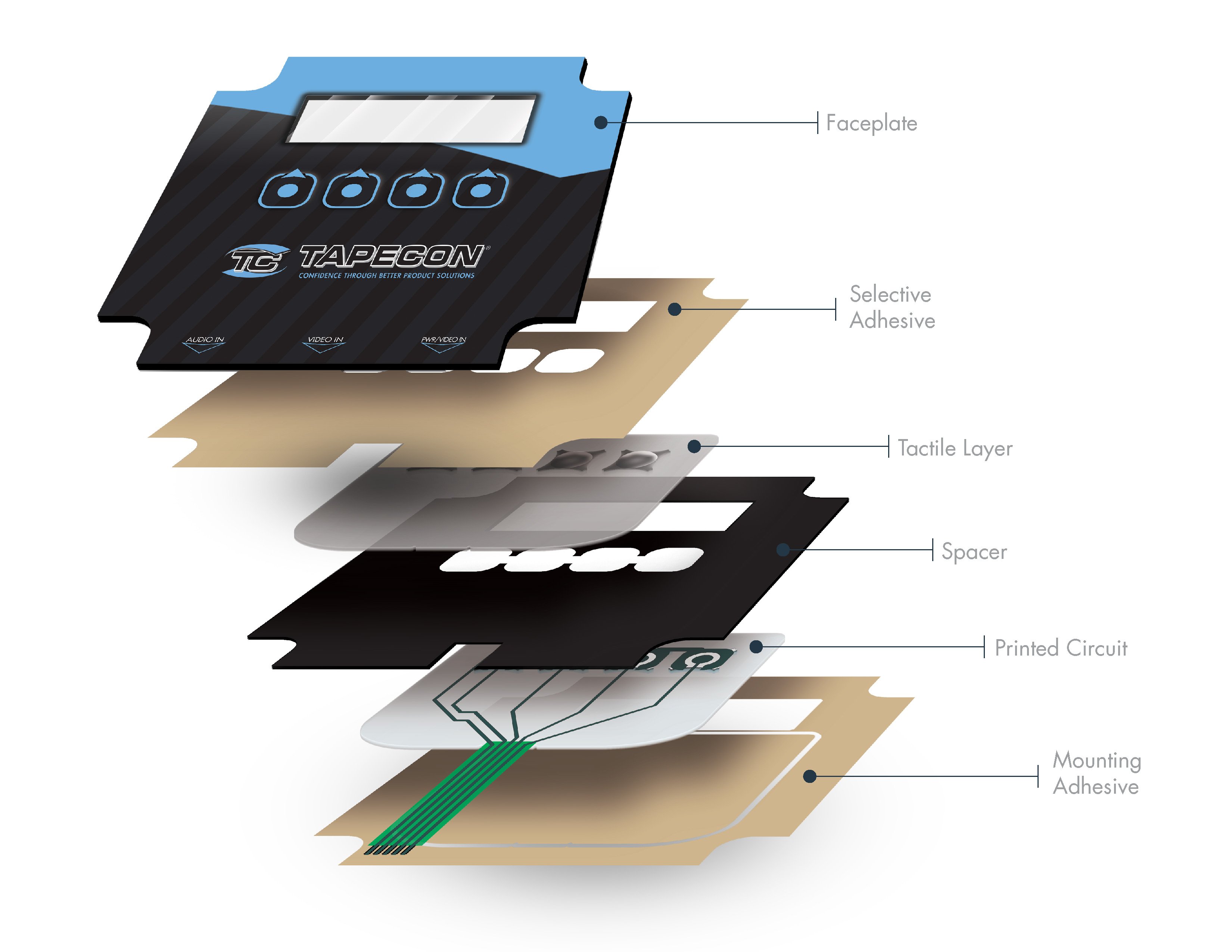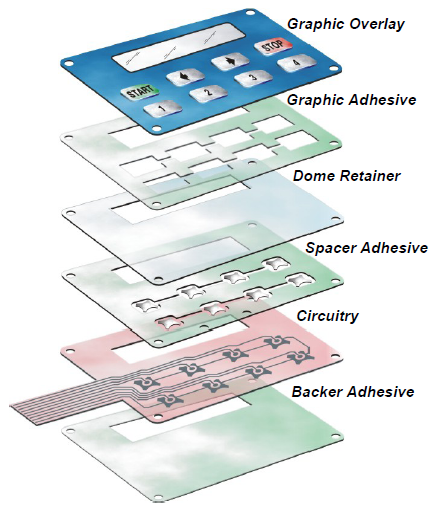The Production Refine Behind Membrane Change: What You Required to Know
The manufacturing process behind membrane layer changes combines cautious layout, product choice, and quality assurance. It begins with understanding the details of membrane layer button design and proceeds with numerous phases, consisting of material selections and printing strategies. Each stage plays an important role in ensuring functionality and longevity. The complexities of layer building and the rigorous screening requirements may reveal insights that are not quickly noticeable. What lies past these fundamental elements?
Recognizing Membrane Layer Change Style
Membrane switches may appear simple at initial look, their style includes elaborate factors to consider that guarantee capability and sturdiness. The design procedure begins with a complete understanding of user requirements, including the user interface's intended application and ecological aspects. Comfort designs is a crucial element, as the format must promote ease of use while guaranteeing that tactile comments satisfies user expectations.Moreover, the layering of elements, such as visuals overlays, glue layers, and conductive traces, have to be specifically crafted. membrane switch. This layered configuration not just influences the switch's responsiveness however also affects its longevity. Focus is provided to the sealing strategies utilized to protect versus moisture and dirt, which could endanger performance. Additionally, design factors to consider expand to visual appeals, where color design and aesthetic clarity enhance user experience. Eventually, the style of membrane switches over equilibriums functionality, user experience, and sturdiness, making certain that they satisfy the demands of various applications successfully
Materials Made Use Of in Membrane Switch Over Manufacturing
When choosing products for membrane switch manufacturing, it is necessary to ponder both performance and durability. The key products include polyester and polycarbonate movies, which give adaptability and stamina. These movies are usually covered with adhesive to assure correct bonding to substrates. Conductive inks, normally made up of silver or carbon, are vital for creating electrical links within the button, allowing for reputable operation.Additionally, a safety layer, such as a difficult coat, is regularly applied to enhance scratch resistance and long life. The option of backing product, such as acrylic or foam, can considerably impact the switch's responsive feel and general customer experience. Additionally, various ecological variables, including temperature and moisture, need to guide product option to guarantee peak efficiency in specific applications. Eventually, the best mix of products adds to the membrane layer switch's capability and life expectancy, making informed selections necessary for manufacturers.
The Printing Process: Creating Video and Text
The printing procedure in membrane layer switch manufacturing plays a significant duty in creating high-quality graphics and message. Various visuals layout strategies are utilized to guarantee visual charm and performance, while mindful ink selection approaches are vital for longevity and efficiency. Understanding these components is fundamental for achieving finest lead to membrane layer switch style.
Graphic Design Techniques
Graphic design techniques play a necessary duty in the printing procedure of membrane layer buttons, as they define just how graphics and text will eventually appear on the end product. Effective graphic design involves the critical use of shades, formats, and typefaces to improve readability and visual charm. Developers usually utilize vector graphics for scalability, guaranteeing that pictures continue to be sharp at various dimensions. Additionally, attention to contrast and alignment is vital, as it influences customer communication and visual quality. The unification of branding components, such as logos, should be taken care of with care to keep brand name honesty. Overall, thoughtful graphic style methods contribute considerably to the performance and attractiveness of membrane layer buttons, influencing customer experience and item performance.
Ink Choice Approaches
Choosing the appropriate ink is essential for accomplishing the wanted visual high quality and resilience in membrane switch production. Various ink kinds are utilized, including solvent-based, water-based, and UV-curable inks. Each type uses distinct characteristics, such as resistance, adaptability, and attachment to ecological variables. Solvent-based inks are usually preferred for their sturdiness and dynamic shades, while water-based inks are a lot more environmentally friendly however might have constraints in bond. UV-curable inks give quick healing and durable efficiency. In addition, color matching techniques guarantee that the picked inks line up with design requirements. Eventually, the option of ink need to take into consideration variables such as application method, substrate compatibility, and end-use demands to accomplish remarkable cause membrane layer switch graphics and text.
Layer Building and Assembly

Material Option Process
A mindful selection of products is important in the manufacturing procedure of membrane switches, as it directly influences capability and longevity. The main products made use of consist of polyester, polycarbonate, and various conductive inks. Polyester is typically favored for its superb resistance to chemicals and abrasion, making it appropriate for severe atmospheres. Polycarbonate, on the other hand, offers superior clarity and impact resistance, which is useful for applications needing exposure and toughness. Conductive inks, pop over to this site normally made up of silver or carbon, are crucial for producing trustworthy electric paths. Furthermore, the selection of adhesive materials affects the total stability of the button - membrane switch. Evaluating variables such as environmental direct exposure, responsive feedback, and visual needs overviews makers in choosing the most effective products for their particular applications
Layer Attachment Strategies
Adhering layers in membrane switch building and construction is an important procedure that guarantees functionality and durability. Numerous attachment methods are utilized to secure suitable bonding in between layers, which normally consist of making use of adhesives, warmth, and stress. Pressure-sensitive adhesives (PSAs) are frequently utilized for their simplicity of application and prompt bonding capabilities. Additionally, thermal bonding methods can be applied, where warmth is made use of to trigger adhesive buildings, protecting a solid bond. The choice of attachment approach greatly depends upon the products entailed and the certain application needs of the membrane layer switch. Correct positioning and consistent application of adhesives are vital to prevent flaws, safeguarding the button operates effectively throughout its desired life-span.
Quality Control Steps
Assuring quality control during the layer building and assembly of membrane buttons is essential for maintaining performance and integrity. This process usually involves several essential actions, including thorough assessments at each stage of manufacturing. Manufacturers utilize innovative testing techniques, such as peel tests and attachment evaluations, to confirm the integrity of layer bonds. Additionally, aesthetic assessments are carried out to identify any issues in printing or material incongruities. Ecological problems, such as temperature level and moisture, are carefully kept track of to guarantee ideal treating and adhesion. Moreover, normal calibration of equipment aids maintain accurate production standards. By implementing these top quality control measures, producers can considerably minimize the threat of product failure, guaranteeing that the final membrane layer switches fulfill the required specs and customer expectations.
Checking and Top Quality Control Steps

Innovations in Membrane Layer Change Technology
As improvements in technology remain to progress, membrane switches are gaining from cutting-edge advancements that boost their performance and individual experience. One significant advancement is the integration of capacitive touch technology, which enables more responsive and user-friendly customer interfaces. This shift not just enhances visual appeals yet also decreases mechanical deterioration, expanding the lifespan of the switches.Additionally, developments in visuals overlay materials have brought about boosted durability and resistance to environmental aspects such as wetness and UV light. These materials now supply boosted clearness and brightness, additional elevating the visual appeal.Furthermore, the unification of clever technology is transforming membrane switches over right into interactive control panels, allowing connection with IoT tools. This connectivity fosters a smooth individual experience, leading the method for applications in various sectors, from health care to customer electronic devices. Jointly, these innovations placement membrane layer changes as crucial components in modern-day gadget layout.
Frequently Asked Concerns
How much time Does the Membrane Layer Switch Production Refine Take?
The period of the membrane layer switch production process can vary significantly. Aspects such as complexity, materials utilized, and manufacturing quantity influence timelines, with regular manufacturing ranging from a few days to several weeks for completion.
What Are the Common Applications for Membrane Layer Switches?
Membrane layer switches are commonly used in different markets, consisting of automotive controls, family devices, clinical tools, and consumer electronics (membrane switch). Their adaptability and resilience make them suitable go to this site for applications needing straightforward interfaces and reliable performance the original source in varied atmospheres
Can Membrane Switches Be Custom-made for Specific Needs?

What Is the Lifespan of a Typical Membrane Change?
The life expectancy of a common membrane layer switch differs, but generally, it varies from 1 to 5 million cycles. Variables such as use, setting, and material top quality substantially influence sturdiness and general performance over time.

Are Membrane Changes Eco-friendly?
The environmental friendliness of membrane layer changes varies. Some products utilized might not be recyclable, while others can be environmentally friendly. The total effect depends upon manufacturing materials and techniques, demanding cautious factor to consider throughout selection and disposal. The manufacturing process behind membrane changes combines mindful style, material option, and quality control. It begins with recognizing the ins and outs of membrane button style and proceeds with numerous stages, consisting of product choices and printing techniques. When selecting materials for membrane layer switch production, it is essential to ponder both performance and toughness. A mindful selection of products is essential in the production process of membrane layer buttons, as it straight influences capability and durability. The choice of adhesion approach largely depends on the products entailed and the certain application demands of the membrane switch.